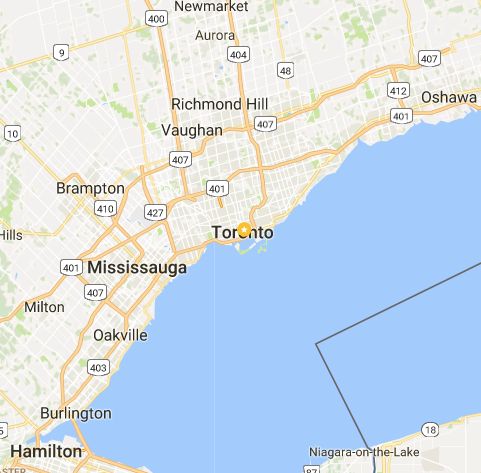By Tamara Jones

Sun setting behind the Toronto skyline.
The daily commute of Tina Hafizy, a 21-year-old Politics student, consisted of a 15-minute walk from her parents’ suburban home, a 40-minute bus ride, and a 40-minute subway ride to Ryerson University in the heart of Toronto. After a year of commuting, she relocated to an apartment within walking distance of campus. However, the convenience of a shorter commute comes with a hefty price tag.
Following in the footsteps of cities like New York and London, living in Toronto has become a luxury that few can afford. In October 2017, Statistics Canada announced that housing costs in Toronto had surpassed Vancouver, making it the most expensive city in the country.
Toronto is a hub for innovation and investment with the overwhelming majority of jobs in the province being concentrated around the city. The skyline, known for the iconic CN Tower, is crowded by condominiums meant to address the population boom. But for youth and other low-income residents, the changing demographics are a serious financial blow.
In December 2016, the Government of Ontario passed legislation to create more affordable housing, but the changes may be too little too late. “Toronto is becoming an attraction for new money which will help the economy, but when it comes to creative, young energy I don’t think [the City] is investing in the culture,” said Hafizy.
Hafizy lives in Chinatown, a location popular with youth due to its proximity to the downtown core and relatively cheap accommodations. She lives in a small basement apartment with six roommates. “Sometimes other people live in their rooms so it can be even more than that,” said Hafizy. Her monthly rent, while “dirt cheap” is still unaffordable and she relies on her parents to help her cover her costs.
Hafizy’s mother immigrated from Iran and her father came to Canada from Afghanistan with refugee status - both received post-secondary educations in their respective countries. Statistics Canada reports that children of university-educated parents are more likely to attend university themselves.
“Participation in higher education is strongly correlated with higher earning potential and health outcomes,” said Andrew Clubine. As the president of the Ontario Undergraduate Students’ Association (OUSA), Clubine sees virtue in postsecondary education, but advocates for improvement in areas that the government has not addressed adequately.
“Each year, students pay a bigger portion of their cost of education,” said Clubine. OUSA advocates for sustainable post-secondary funding models and more robust financial aid programs, including changing the way that Ontario Student Assistance Program (OSAP) assesses need to better reflect the cost of living where students choose to study.

Map of the Greater Toronto Area and surrounding regions.
Toronto isn’t the most youth-friendly city in Canada, but highly regarded schools, relatively easy access to public transportation, and proximity to industry persuades students to put financial health on the backburner.
The majority of students in Ontario graduate with debt. As of 2014, the average OSAP participant graduated with over $24 000 in debt, not considering private loans that some take out to cover the remainder of their costs. Currently, OSAP requires participants to begin repaying their loan six months after their last consecutive semester, unless they apply and are accepted to the Repayment Assistance Plan which can defer payments until they have a steady income.
Hafizy, who plans to pursue a graduate degree in the future, explains that her education thus far has been theoretical and hasn’t given her what she thinks she needs to compete in the job market like work-integrated programming and digital humanities focused curriculums. Increasingly, Canadian students invest in graduate degrees to make themselves stand out in the crowded job market, burdening themselves with even more debt. Hafizy says her parents are keeping the economic realities that millennials face in perspective as they plan for their futures, but hopes that one day she’ll be able to take care of them. Right now it’s just not feasible.
Hafizy’s parents came to Canada and created a prosperous life for their family, one which enabled them to support their children who will most likely swim against the tide of a rapidly changing economy, but where will that leave them in the future? Youth must have the opportunity to amass even more wealth than their parents to compensate for ever-rising costs of living. Lower-income families may not have the means to support their children through post-secondary education and young adulthood. In both cases, intergenerational mobility stagnates.
Ontario is home to many overeducated and underemployed citizens who don’t get the opportunity to utilize their knowledge and skills. Improving the relevance of educational content, raising wages to levels that allow families to thrive rather than just get by, enticing industry to relocate to other areas of the province, and addressing stigma surrounding skilled trades may help to revitalize Ontario’s labour force and decelerate the cost of living in the Greater Toronto Area.
—
Tamara Jones is a Toronto-based freelance journalist. She received her BA (Hons) from Ryerson University with a major in Global Studies and minors in News Studies and Sociology. She strives to craft compelling stories that showcase diverse perspectives on contemporary issues. Learn more about her work at www.tamarajones.ca.
This post is a part of a series on intergenerational mobility hosted by Friendship Ambassadors Foundation (FAF) in support of the World Bank's #EndPoverty campaign. The views and opinions expressed in this article are those of the author and do not necessarily reflect those of FAF or the World Bank. To see all posts in the series, click here.
